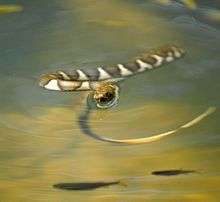Boulenger's keelback
| Boulenger's keelback | |
|---|---|
 | |
| Xenochrophis asperrimus Taken by: Gunnar Pettersson(Wildlife Artist) at Sinharaja, Sri Lanka on 2008-02-19. | |
| Scientific classification | |
| Kingdom: | Animalia |
| Phylum: | Chordata |
| Class: | Reptilia |
| Order: | Squamata |
| Suborder: | Serpentes |
| Family: | Colubridae |
| Genus: | Xenochrophis (Günther, 1864)[1] |
| Species: | X. asperrimus |
| Binomial name | |
| Xenochrophis asperrimus (Boulenger, 1891)[2] | |
| Synonyms | |
|
Tropidonotus asperrimus Boulenger, 1891:281 | |
Boulenger's keelback[2] or Sri Lankan keelback,[4] (Xenochrophis asperrimus) is a nonvenomous and common water snake endemic to Sri Lanka.[5][6][7][8]
Habitat
X. asperrimus is found in Sri Lanka,[9][10][11] in both dry and wet climatic zones up to 1000 m above mean sea level. It is abundant in waterways, such as flooded rice fields, ponds, lakes, marshes, rivers and streams.[2][6][12]
Characteristics
The body of the X. asperrimus is short and cylindrical, and has a clear neck and slightly pointed head. The eyes have rounded pupils, and the nostrils are narrow, directed slightly upwards. The tail is long. At birth, they are 100 mm and grow to an adult length of 400–700 mm. The female is longer.[2][6][7]
Scales
It has one pair of internasals; the posterior parts are narrow. One loreal, preocular, postocular and three temporals are found. Of the 9 supralabials, 4 and 6 connect with the eye. Ventrals number 131–146, and the undividedsubcaudals are 73–93 in count. The midbody consists of 19 rows of scales. The dorsal scales are strongly keeled and rough.[1][2][7][12][13]
Colour
The dorsal body color of X. asperrimus is olive brown. The anterior half of the body has 20–32 distinct large black spots or cross bars. The posterior body may lack them or may be in light-colored irregular shapes. The head is dark in color. Two black strips run behind the eyes. The ventral body is white. It can be easily identified by dark spots or bars on the first half of the body and two dark lines behind the eyes.[2][6]
Behavior
Boulenger's keelback is oviparous, diurnal and nocturnal. In dry conditions during the summer, it undergoes aestivation. It is active in water bodies in search of its prey, which consist mainly of fish and frogs. It is known to be very aggressive. When threatened, it attempts to bite, by flattening its head and neck as does the cobra. The bite may cause wounds. Also, it may release noxious odor.[2][6]
Breeding
The gestation period is 55–67 days. Females do not guard the clutches of eggs, but they stay close to the nest. They lay clutches of four to 30 eggs between September and October.[2][6][12]
Common names
References
- 1 2 Vogel, G. & David, Patrick (2006). "On the taxonomy of the Xenochrophis piscator complex (Serpentes, Natricidae)" (PDF). Herpetologica Bonnensis. II: 241–246.
- 1 2 3 4 5 6 7 8 Boulenger, G.A. (1891). "Description of new oriental reptiles and batrachians". Annals and Magazine of Natural History. Taylor and Francis, Ltd. London. 6: 279–283.
- ↑ Smith, M.A. (1943). "3. Serpentes". The Fauna of British India, Ceylon and Burma, Including the Whole of the Indo-Chinese Sub-Region. Reptilia and Amphibia. Taylor and Francis, Ltd. London. p. 583.
- ↑ Bambaradeniya, Channa N. B. & Sri Lanka, IUCN (2006). The Fauna of Sri Lanka: Status of Taxonomy, Research, and Conservation. IUCN. p. 156. ISBN 9789558177518. LCCN 9558177512.
- ↑ Das, I. & De Silva, A. (2005). Photographic guide to snakes and other reptiles of Sri Lanka. New Holland Publishers. p. 144.
- 1 2 3 4 5 6 7 Suranjan Karunarathna, D. M. S. & Thasun Amarasinghe, A. A. (2011). "A Preliminary Survey of the Reptile Fauna in Nilgala Forest and its Vicinity, Monaragala District, Sri Lanka". Taprobanica. 3 (2): 69–76.
- 1 2 3 Taylor, Edward H. (1950). "The snakes of Ceylon". University of Kansas Science Bulletin. 33 (14): 519–603. ISSN 0022-8850.
- ↑ Xenochrophis asperrimus at the Reptarium.cz Reptile Database. Accessed 19 January 2016.
- ↑ Beolens, Bo; Watkins, Michael & Grayson, Michael (2011). The Eponym Dictionary of Reptiles. JHU Press. pp. 33–35. ISBN 9781421401355. LCCN 1421401355.
- 1 2 De Silva, A. (1998). "Snakes of Sri Lanka: a checklist and an annotated bibliography". Dept. Wildlife Conservation/GEF/UNDP/FAO, Colombo.
- ↑ Wall, Frank (1921). Ophidia Taprobanica or the Snakes of Ceylon. Colombo Mus. (H. R. Cottle, govt. printer), Colombo. p. 581.
- 1 2 3 Boulenger, G.A. (1893). "Catalogue of the snakes in the British Museum.(Natural history) Vol. I". Taylor and Francis, London: 448.
- ↑ Janzen, P.; Klaas, P. & Ziesmann, S. (2007). "Sri Lankas Schlangenfauna". Draco. 7 (30): 56–64.